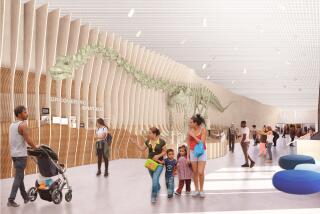T-Rex Named Sue Gets Lab’s Star Treatment
- Share via
CHICAGO — It may be the largest puzzle you’ll ever see.
Piece by piece, in a high-tech, glass-walled laboratory, Chicago’s Field Museum will put together Sue, its prize Tyrannosaurus rex.
The lab, on the museum’s second floor, was designed to show visitors how fossils are restored. For the next two years, it will showcase Sue’s resurrection.
“The lab is designed to show everyone the process of science,” said Peter Laraba, a geology specialist in the Field Museum’s education department. “As we build Sue, we want to show people, especially kids, how we try to answer the mysteries of one of the most infamous dinosaurs.”
The 65-million-year-old Sue was discovered in a South Dakota riverbed eight years ago by Chicago-area native Susan Hendrickson. Sue, made up of about 300 bones, is considered the largest and most complete tyrannosaur ever found.
The fearsome creature, which cost the museum $8.3 million, should be greeting visitors by 2000.
Posing Sue on two legs is the easiest part of the entire project, museum staff say. Sue will lean on a self-supporting iron structure, and museum scientists already know how the bones fit together.
“Once you’ve seen a bird or a human skeleton, they’re all the same,” said Bill Simpson, who is in charge of putting Sue together. “A vertebrate is a vertebrate, and we know how to put them together pretty easily. What’s difficult is preparing the bones.”
In one of the exhibit’s two rooms, two people use small brushes, picks and an air-compression device that works like a tiny jackhammer to remove matrix--million-year-old dirt--from fossils.
The matrix is relatively soft and easy to remove, but workers still go slowly to avoid scratching or blemishing the skeleton.
“I’ve spent seven weeks on one vertebra,” Bob Masek said. “Some bones are more fun to work on than others, and each bone calls for a different strategy.”
The final layer of matrix is removed in an adjacent room by a worker who uses an air abrasion machine to blast the dirt away with baking soda. When that’s done, the fossils are transformed from a dusty tan shade to dark brown.
More to Read
Sign up for The Wild
We’ll help you find the best places to hike, bike and run, as well as the perfect silent spots for meditation and yoga.
You may occasionally receive promotional content from the Los Angeles Times.






